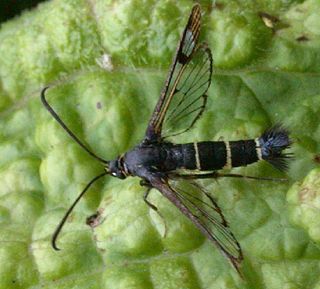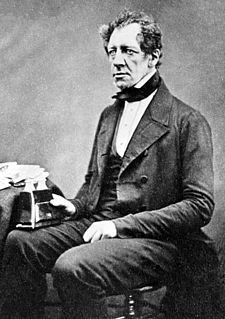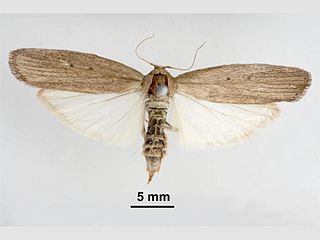
The Sesiidae or clearwing moths are a diurnal moth family in the order Lepidoptera known for their Batesian mimicry in both appearance and behaviour of various Hymenoptera.

The Hepialidae are a family of insects in the lepidopteran order. Moths of this family are often referred to as swift moths or ghost moths.

Francis Walker was an English entomologist. He was born in Southgate, London, on 31 July 1809 and died at Wanstead, England on 5 October 1874. He was one of the most prolific authors in entomology, and stirred controversy during his later life as his publications resulted in a huge number of junior synonyms.

Cosmosoma is a genus of tiger moths in the subfamily Arctiinae. The genus was erected by Jacob Hübner in 1823.

Pseudosphex is a genus of tiger moths in the family Erebidae. The genus was erected by Jacob Hübner in 1818. These moths are mimics of a variety of Hymenoptera. The prefix pseudo means "false", and Sphex is a genus of wasps.
Deinopa is a genus of moths of the family Erebidae erected by Francis Walker in 1856. The genus was previously classified in the subfamily Calpinae of the family Noctuidae.
Ogoa is a genus of moths in the subfamily Lymantriinae erected by Francis Walker in 1856. The species are known from Africa.

Acronicta impressa, the impressive dagger moth or willow dagger moth, is a moth of the family Noctuidae. The species was first described by Francis Walker in 1856. It is found from western Canada to north-western Mexico.

Andropolia contacta, the Canadian giant, is a moth in the family Noctuidae. The species was first described by Francis Walker in 1856. It is found from Alaska to Newfoundland, south to New England, New York, Colorado, and southern British Columbia. It has also been recorded from California.

Harrisimemna trisignata, or Harris's three spot, is a moth of the family Noctuidae. The species was first described by Francis Walker in 1856. It is found in North America from Ontario, Quebec, New Brunswick, Nova Scotia, Newfoundland and Labrador, Alberta and Saskatchewan, south to Arizona. In the United States it has been recorded in Maryland, Pennsylvania, Wisconsin, Georgia, Illinois, Indiana, Iowa, New York, Ohio, Oklahoma, Tennessee, Texas and Virginia.
Stigmella maoriella is a species of moth in the family Nepticulidae. It is endemic to New Zealand. It is classified as Not Threatened by the Department of Conservation.

Eldana is a genus of moths of the family Pyralidae containing only one species, the African sugar-cane borer, which is commonly found in Equatorial Guinea, Ghana, Mozambique, Sierra Leone and South Africa. Adults have pale brown forewings with two small spots in the centre and light brown hindwings, and they have a wingspan of 35mm. This species is particularly relevant to humans because the larvae are a pest of the Saccharum species as well as several grain crops such as sorghum and maize. Other recorded host plants are cassava, rice and Cyperus species. When attacking these crops, E. saccharina bores into the stems of their host plant, causing severe damage to the crop. This behavior is the origin of the E. saccharrina's common name, the African sugar-cane borer. The African sugar-cane borer is a resilient pest, as it can survive crop burnings. Other methods such as intercropping and parasitic wasps have been employed to prevent further damage to crops.

Sthenopis pretiosus, the gold-spotted ghost moth, is a species of moth of the family Hepialidae. It was first described by Gottlieb August Wilhelm Herrich-Schäffer in 1856. It can be found in found Brazil, Venezuela and in the north-eastern United States and south-eastern Canada.
Lophocampa niveigutta is a moth of the family Erebidae. It was described by Francis Walker in 1856. It is found in Brazil and Colombia.

Longicella mollis is a species of moth of the family Noctuidae first described by Francis Walker in 1856.

Drymoea veliterna is a species of moth in the family Geometridae first described by Herbert Druce in 1885. This species can be found in Bolivia.

Eudonia sabulosella is a species of moth in the family Crambidae. This species is endemic to New Zealand and is regarded as being common. The larvae of this species are known to damage pasture in New Zealand.
Toosa is a genus of moths of the family Thyrididae erected by Francis Walker in 1856. The species are found in Africa.

Asaphodes adonis is a species of moth in the family Geometridae. It is endemic to New Zealand.

Proteuxoa comma is a species of moth in the family Noctuidae. It is endemic to New Zealand. This species is very similar in appearance to P. tetronycha.













